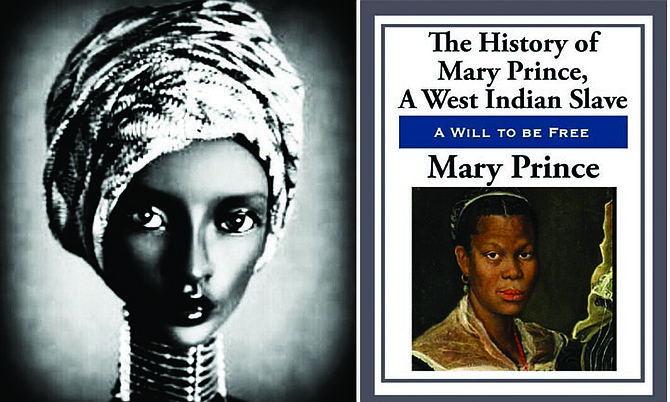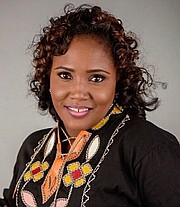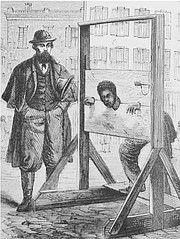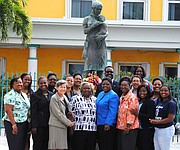LEFT: An imagined image of Queen Ophelia, Queen of the South from bahamianology.com. RIGHT: A book cover from the autobiography of Mary Prince.
By FELICITY DARVILLE
The month of March is celebrated internationally as Women’s History Month. March 8 is International Women’s Day, which is robustly commemorated here in The Bahamas. It is a day dedicated to honouring the achievements of women throughout history and across the globe, and is typically a day for women from different backgrounds and cultures to band together to fight for gender parity and women’s rights. As women who are succeeding in all spheres of life will be highlighted throughout the month, I thought it important to take a step back in time and look at some of the women in Bahamian history who should never be forgotten.
First, let’s look at a young lady from Crooked Island, whose existence could have easily been forgotten had she not taken a stand for herself - one that she paid for with her life. In the 1820s, Henry and Helen Moss were plantation owners of an estate in Crooked Island. There, a young woman, their slave Kate Moss, would receive such severe treatment from them that she died. Her death sent shockwaves that reached all the way to the British High Courts, and was a case abolitionists made in their quest for an end to slavery.
Kate was a house slave on the Moss plantation. She was accused of theft, insubordination and insolence for refusing to mend her clothes - or so Henry and Helen said. But the punishment they unleashed on her gives indication of a much deeper picture. On July 22, 1826, she was shackled and locked in the stocks - a torture device where you are required to stand with your wrists and neck suspended.
There, Kate stood until August 8. During that time, she was only removed from the stocks to be whipped. Helen rubbed Kate’s eyes with hot pepper while she was in the torture device. Kate would be given orders that were impossible for her to fulfil in the stocks. Then she would be removed to be whipped. At one point, even her father had to whip her, whether by order of the Mosses or because he wanted to allay some of the torture his daughter experienced.
Once removed from the stocks after 17 long days and nights, she was commissioned to be a field slave and, after “refusing” to work or likely because she was physically unable to perform the tasks, she was placed in a sweat box, and flogged over and over, until she died in the hot sun in the fields of Crooked Island.
Her fate reveals the likelihood of other reasons for her treatment. Did Kate really refuse to mend her clothes? Or, why did she refuse to mend her clothes? Could this young teenage woman have been robbed of her chastity and refused to get rid of the evidence? What we do know is that Kate “refused”… and refusing during the time of slavery was crime enough. How brave was this young woman to defy her slave drivers and stand up for herself, knowing that it would cost her her life.
The Mosses received a five month prison sentence and a 300-pound fine for this atrocity. Later, however, Governor of The Bahamas, General Lewis Grant appealed for their punishment to be overturned.
Eventually, the story of Kate Moss would be told over and over during the 1820s and 30s as abolitionists referred to the case to prove their point for a need to end the barbaric practice of slavery all over the world. Kate would not have known or thought that her actions to stand up for herself would become an act of defiance that was strong enough to make an impact on slavery worldwide. They referred to her as “Poor Black Kate” but she is Kate Moss, a young lady born in The Bahamas whose impact on the history of the world should never be forgotten.
Some of the most vivid stories of what slaves in the Caribbean and the Bahamas endured were told by abolitionist and autobiographer, Mary Prince. She was born in Bermuda in 1788 but her journey of enslavement took her to other countries in the region, including having to work in the Bahamian salt ponds. Her narrative, assisted my Thomas Pringle, “The History of Mary Prince” was the first account of the life of a black woman to be published in the United Kingdom. She described the brutalities of enslavement and it had a galvanizing effect on the anti-slavery movement.
“Mary Prince’s autobiography gives sound examples of the harsh realities on the Bahamian salt plantation and unequivocally dispels the myth of slavery being milder/easier in the Bahamas,” says historian and activist, Christopher Davis.
“Enslaved in the U.S.A., Antigua, England and The Bahamas, her most difficult and traumatic experience was on a typical salt plantation in The Bahamas, a seasonal commodity produced on every Bahamian Island. Crooked Island, Acklins, Inagua, Little Exuma, Ragged Island, Long Cay and the entirety of the Turks and Caicos were all islands whose economies were dependent on the raking of salt. The cruelty that Mary Prince received and witnessed was so bad that it is alleged that it soften the hearts of the most avid pro-slavery voices. She greatly influenced global abolitionist movements, pointing at her experience on Grand Turks being the worst period of her life as a slave.”
Another woman worthy of note has no known name, but her statue has been sitting in downtown Nassau, largely unnoticed for decades.
Whether she is an actual woman or the representation of the Bahamian woman in a period of time, we should all stop by and take note of the statue dubbed the “Bahamian Black Madonna and Child” by late Parliamentarian Oscar Johnson Sr.
The often overlooked statue sits at the eastern end of Prince George Wharf and is seen by the majority of tourists entering Nassau by cruise ship, but not often seen by Bahamians.
It depicts a black Bahamian woman with two braids crowning her forehead and hanging down her face. She wears a blouse and knee-length skirt and has a money pouch slung over her shoulder.
Her greatest accessory is the naked brown baby clutching her dearly with his head on her chest. Each nappy tendril delicately carved, and eyes looking out to a world where he seems to know that his greatest source of comfort from it will come from her. Her gentle eyes seem to look down and away, deep in thought.
It was unveiled in Rawson Square on August 11, 1974. It was commissioned by MP Johnson (Cat Island representative in the House of Assembly from 1968 - 1976) and sponsored by a Syntec Petroleum Company executive. During the time of Independence, Bahamians would have traversed the area for business regularly. The statue was sculpted by Canadian Randolph Johnston. He, his wife and three sons sailed off on a schooner from the North American continent and settled in Abaco, living first in a cave, in a place they named Little Harbour in Abaco.
On International Women’s Day 2014, the children of Oscar Johnson got together to celebrate a statue that their father, as a Parliamentarian, wanted Bahamians to respect and admire.
The barefoot woman holding the boy child is indicative of the life many Bahamians of the time could relate to, whether born in the Family Islands or even over-the-hill in New Providence. These women, even without the opportunities for education and advancement that present themselves today, were often the bedrock of their families.
They helped nurture their children in such a way that we have seen many a great Bahamian rise up from seemingly unfortunate circumstances to become people of influence all around the world.
Former Minister of Youth, Sports and Culture Dr Daniel Johnson brought together several Bahamian women to commemorate the statue including Minister of Social Services and Community Development Melanie Griffin; his sisters, former Speaker of the House of Assembly Italia Johnson, former Senator and Consul General Gladys Johnson-Sands, educator Cora Johnson-Cooper, and attorney Kathleen Johnson-Hassan; former Minister of State for Social Development Loretta Butler-Turner; Senator Hope Strachan; national archivist and historian Dr Gail Saunders; cultural icon Arlene Nash-Ferguson; Deputy Permanent Secretary Phedra Rahming, Bahamian hero Ruth Dobouze, and his daughter, Danielle Pindling-Johnson among others.
“This is a day when the world honours women and I wanted to demonstrate to the Bahamas that we have national heroines, we have community heroines, we have unsung heroines,” Johnson said.
“We are honouring the past and preserving their story. We must preserve this story of the Black Madonna and Child. It was erected by my father to honour the Bahamian woman and today was a good day to recognise how far we have come. I brought my daughter to expose her to the story of the Black Madonna and Child and how we crossed over on dry land but for the grace of God.”
Italia Johnson shared: “I am particularly honoured to be here as a Bahamian woman to recognise the commissioning of this statue in the 1970s. It came as a result of some struggle, but it is here. It is a worthy tribute to the Afro-Bahamian woman. Bahamian women have been the bedrock of our society, not only Afro-Bahamian women, but also women in general have made contributions to families and the development of our nation. I would admonish women to have a look at this statue and commemorate it with their families.”
Dr Gail Saunders said she considers the statue a “very fine tribute to Bahamian women”.
“It is a very beautifully carved statue, it shows a strong woman and also a child and that is symbolic itself. We must honour our women and empower them, and the child signifies that it will go on and to me that is very important.”
Eventually, this symbol of Bahamian identity was moved from its place near the still-standing statue of Queen Victoria on her throne and placed in obscurity.
Finally, let the record reflect that in Bahamian history, a black queen lived among us. In 1884, African societies in The Bahamas, including the Yoruba and Ebo (in Bain and Grants Town and other areas) and the Congo (of Fox Hill) were different from other blacks in The Bahamas. They were not emancipated British slaves. They came to the Bahamas as Africans who were liberated from slave ships bound for Cuba, America and other non-British slave colonies.
As bahamianology.com puts it: “The wise old generation of these African tribes were dying. It was the old generation, the ones who had emerged from the holds of slave ships in a new country, who were now closing their eyes in the dust of foreign soil. Now a new generation of Africans, with English names, and the English tongue, knowing nothing of the past, were trying to hold on to some traditions, in honour of their ancestors.”
One very important West African tradition was the appointment of a queen who would become monarch and her family, a royal family.
Saturday, September 9, 1884, was chosen as Coronation day for Ophelia Rutherford.
History records that at 11:30am on that day, the advisors, companions and members assembled at the Hall of the Yoruba Friendly Society, the Life Guard and the Band of the Grant’s Town Friendly Society gathered.
A royal salute was fired by the Life Guard and the national anthem was played as she entered the hall and ascended her throne.
The meeting was called to order, and a prayer was lifted by secretary John Ashford.
A speech was given by her private secretary, and the secretary of the Ebo Association.
At 1pm, she was crowned by the association president. A royal salute of 21 guns was fired and the band once again played the national anthem - a true Bahamian queen coronation.
From the hall, the band proceeded to the royal banquet, followed by Her Majesty Queen Ophelia, then the president, her companions, advisors and subjects, with the life guard at the rear.
Queen Ophelia’s job was to be the “ologbon”, the wise one who would settle disputes, impart knowledge, and keep Africa alive in the heart of Grant’s Town, Carmichael, Fox Hill and Adelaide.
She was to mentor a new regeneration of young Afro-Bahamian boys in Nassau successfully into manhood, as generations of queens before her had done.
With this in mind, Bahamian women, remember your history, your worth, and your inevitable bright future.
It only requires wisdom, wit, and tenacity to continue to rise above barriers knowing that throughout the passage of time, Bahamian women have made an indelible impact on the world.








Comments
FreeUs242 3 years, 1 month ago
To all the women in the Bahamas, you are beautiful either way. Just believe in yourself, love what you do and never give up your dreams. Congrats to all the ladies that conquered their dreams and never gave up#YouGotThisLadies #AllWomenIsCelebrated👑💯🙌
Sign in to comment
Or login with:
OpenID